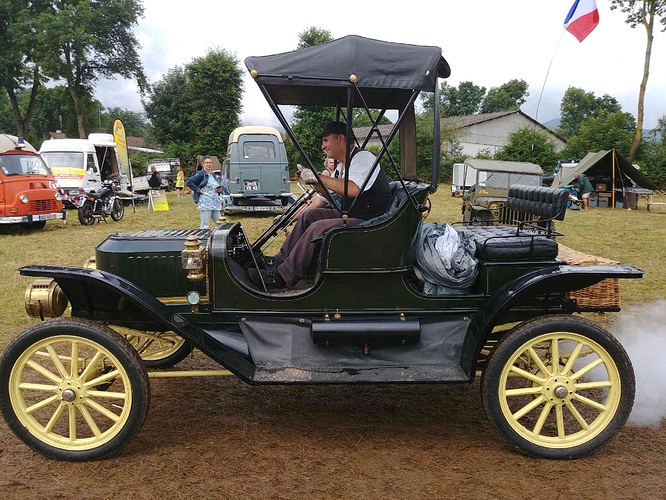Yes. Weight. Complexity. Dedicated maintenance requirements. Extreme precision manufacturing. Exotic expensive heat, pressure and erosion resistant materials need to get that so-called better efficiency.
OVERALL fuel use from cold ambient starting up to working power-use.
THEN energy/mass bleed off loses AFTER stop working use, shut down.
And two of these factors make it easy to see why no external combustion system can beat an IC piston engine system.
System material Mass-heat to power. The material mass’s needed to get to good fuels ionization for T-P power . . . then added to combustion areas mass; the material mass in “steam”, “expansion-gas” T-P power transfer to the mechanical power making parts of the system.
ALL external combustion systems simply require more system mass’s to get up to temperature; absorbing HEAT energy to make the Pressure, to make the pushing power.
New member Luis put up and excellent youtube video of a Brit who acquires an early 1960’s commercially made Stirling system small portable electrical power plant. LISTEN to the presenters words. Click enabled the cc option and read his words.
He did not even present from a cold starting up to power output portion because he said, “it would have taken too long”
He did say that the instruction manual stated to get the top hot end of the engine red glowing hot for full pressure and power capabilty. AND keep it that glowing hot c-o-n-t-i-n-i-o-u-s-l-y.
Old system. No service parts or support available and he chose to not run it full hot side temperature/pressure to not stress/wear/break it.
So for an only 400-600 watt electrical output system he showed only powering a single 100 watt incandescent light bulb.
Now same time era manufactured tiny-small Honda EM600. Same 600 watts rated output. One two pulls on the Honda flat head engine and up and running. Choke off and within less than 2 minutes getting the full 600 watts electrical output.
And yes. These were made in a kerosene fueled version for sale/use into India and Pakistan. Duel bowl carburetor. Started on the sub-gasoline side. Quickly switched to the kerosene side just as soon as the piston crown, valves and under cylinder head metal mass were warmed enough to support kerosene fuel-mist particles ionization combustion break down.
And now 50 years later that small Honda IC pistion system will give you either 4X the power for 4 hours: or a 10 hour 400 watt true standy-by power on just a single gallon US of gasoline.
Sirling performance is still stalled back as a fuel-use burner.
Only a complete fool runs his IC piston engine parts into red glow. Stupid. Sure failures making.
Hot rod/racing grand standing crap. Fine if the grandstand attendees are willing to pay for the show.
Ain’t no way to run a farm, trucking company, railroad, or commercial marine operation.
WHY: move around the world marine still use big massive IC PISTON engines.
Why: move millions of tons across continents Rail still use big IC PISTON diesel/electrics.
Oh folks do love to shout out steady-state numbers!
My dear older sister when she got her new-to-her 2007 Toyota Camry four cylinder loved to crow she was getting 40+ mpg. Sometimes her lie-o-meter would post hers as 44 mpg. Ha! A four cylinder Camry beating a same era Toyota Prius? No way sister dear. Now toggle-back my sister to a long-term lie-o-meter average . . . factoring in cold start warm-ups, and drive-always. Sitting at Tee intersection stop signs. Four and six-way traffic light intersections. Overall mileage of ~32 mpg. That ain’t bad. She is a feather footed driver. Unlike my darling wife racing up to stop signs. Groan. To save time. Burn more gasoline and brake linings, honey-bunny.
In IC piston engine only has to first ionize a small amount of air/fuel. THEN the small relative mass of the piston top upper cylinder wall, valve faces and under head combustion chamber heat quickly to full fuels ionization support, super quick.
You do not have to heat up the whole engine mass to get usable power.
External combustion you must heat up significantly all of the systems mass’s to get to usable power. Expended fuel energy for NO output power is always a loss!
What the super external combustion engine quacks always quick talk past hoping your will not notice.
Buy into their systems. Fuel operate their system, daily, year around, for real working AND YOU WILL NOTICE!
Only Gov’mints, University Geeks can afford to waste away moneys and efforts on steady-state lies.
Just his morning the loggers came to move their John Deere commercial log skidder to another site. Six cylinder inline Diesel. 27F this morning. It has sat unused for 4 weeks now. Glow plugged it to intake air heat for 15 seconds. Cranked to start in 30 seconds. White cold exhaust smoke for 2 minutes. Exhaust hot and clear then. It self powered itself up-ramp onto a high bed truck for road transport.
NO external combustion system historic, current, proposed, could have self-moved itself using that small amount of fuel.
Best case maybe external combustion 30 minutes to warmed up to enough power to pull itself out of it’s own shadow. CONSUMING fuels that whole warming up to usable working power time!
Too long? Too hard to follow?
Easy.
An IC piston engine heats up to working from the inside core, to the outside.
Any external combustion engine system must heat up to working from the whole outside to the inside core.
Just the the Real-of-it, man.
Steve unruh






